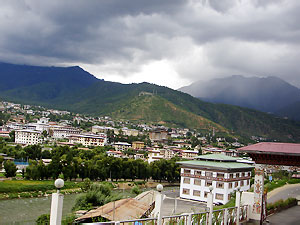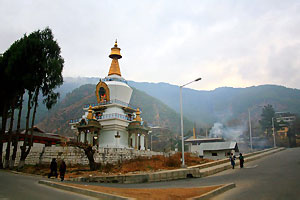|
|
Thimphu Attractions |
|
Tourist Attractions in Thimphu
The various tourist attractions in Thimphu are Tashicho Dzong,
Simtokha Dzong and Stupa. |
|
|
|
Tashichho
Dzong |
|
Tashicho Dzong, the main secretariat building, houses
the main government departments, all the Ministries, the
National Assembly Hall, the office of the King and the
Throne Room and summer headquarters of the Central
Monastic Body. It is also the summer residence of the
monk body and the religious chief, the Je Khempo. This
dzong was first built in 1661, and dominates the town of
Thimphu. Except the central keep, the entire structure
was rebuilt in 1961-62. In the National Assembly Hall,
there is the two-storey high statue of Lord Buddha, wall
paintings which depicts the twelve stages of Buddhahood
and columns |
 |
|
|
of Kanju and
Tenju that depicts the supremacy of religion over politics.
The yearly Thimphu Festival is held in the courtyard directly
in front of the National Assembly Hall. The two largest
Thankas are housed in the Uchi, the tall citadel-type temple
in the middle of two courtyards. These thankas are displayed
to the public only once in 25 years. During the renovation of
Tashicho Dzong, the Uchi was left undisturbed.
Simtokha Dzong
The Simtokha Dzong is situated on a lofty ridge, about 8 kms
from Thimphu. This dzong was built in 1627 by Shabdrung Nawang
Namgyel, the first king of Bhutan. This dzong is the oldest
Dzong in Thimphu and gateway to the Thimphu Valley. This dzong
still enjoys the strategic importance as it did in 1627. The
Dzong houses Rigney School for Dzongkha and monastic studies.
There are beautiful frescos and slate carvings in Simtokha.
Streets of Thimphu
The most enjoyable experience of being in Thimphu is to taking
strolls around the streets here. Weekend markets of Thimphu
sell everything under the sun that is being created in Bhutan.
Hordes of villagers sell vegetables, newspapers, red chillies,
traditional Bhutanese masks, and carpets. |
|
|
|
Stupa
The stupa-styled monument is also situated in Thimphu.
This monument is dedicated to the late King, His Majesty
Jigme Dorji Wangchuck, the father of modern Bhutan. The
paintings and statues inside the stupa provide a rare
insight into Buddhist philosophy.
Other Attractions
Other important attractions in the city include the new
National Library, the High Court, the Royal Bhutan Golf
Course, |
 |
|
|
Convention
Centre, the School of Arts and Crafts, the Weekend market, the
Changlimithang Stadium, and the National Institute of
Traditional Medicine. |
|